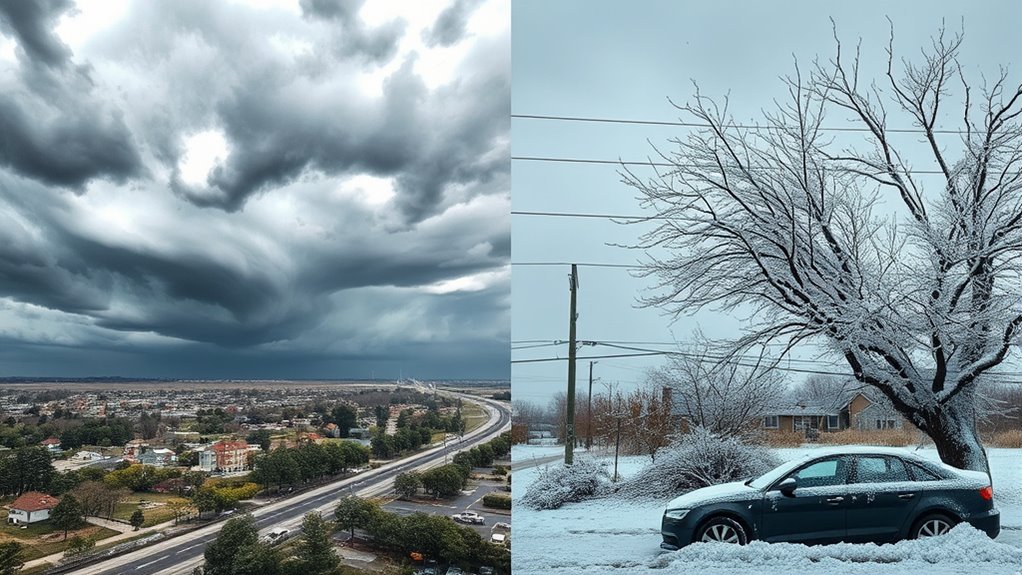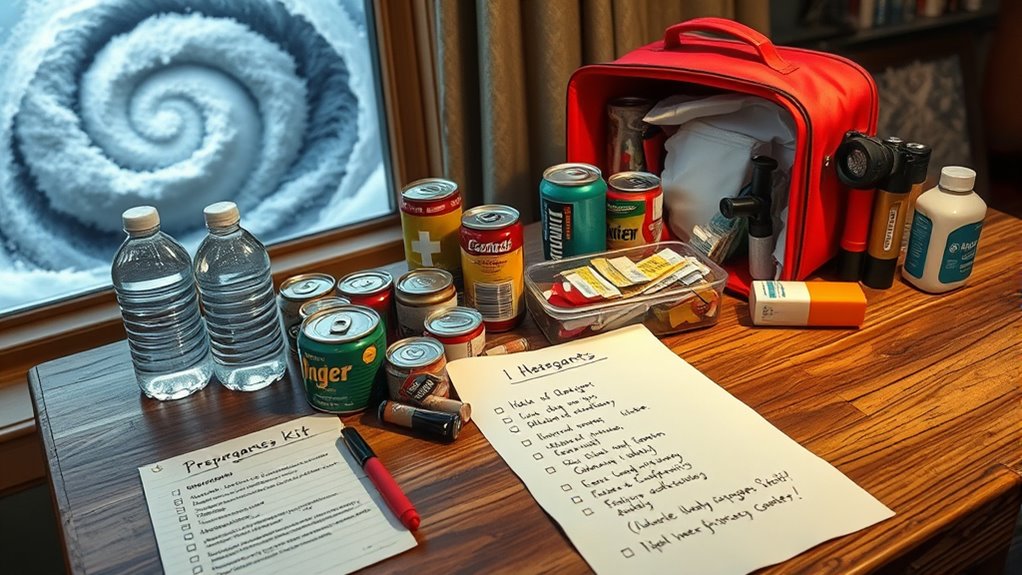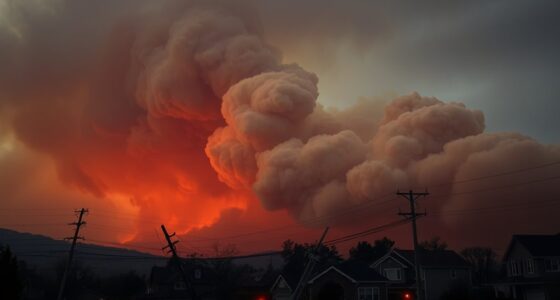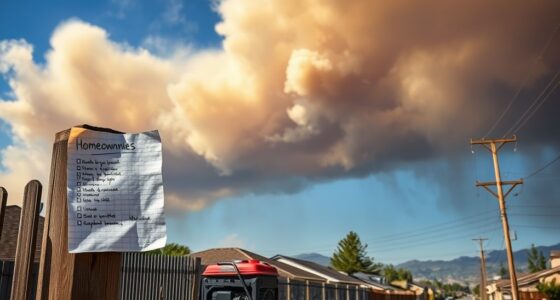Before you start, understand that hurricanes and ice storms require different preparations. For hurricanes, focus on evacuation plans, securing property, and stocking emergency supplies like water and batteries. For ice storms, prioritize preventing power outages, adding extra insulation, and clearing around your home to avoid ice buildup. Each storm type has unique risks and safety steps. Keep exploring to find detailed checklists that help you effectively prepare for either event and stay safe.
Key Takeaways
- Assess local storm risks and understand whether a hurricane or ice storm is more likely in your area.
- Prepare an emergency kit with essential supplies tailored to each storm type, including water, food, and power sources.
- Develop and practice evacuation plans for hurricanes or shelter-in-place strategies for ice storms.
- Protect property by reinforcing windows, doors, and infrastructure using natural materials like wood and stone.
- Stay informed via weather alerts and establish communication plans with family and local authorities.
Key Differences Between Hurricanes and Ice Storms

While both hurricanes and ice storms can cause significant damage, they differ greatly in their origins, characteristics, and impacts. Hurricanes form over warm ocean waters, bringing sustained winds, heavy rain, and storm surges. Ice storms develop when cold air meets moisture, creating freezing rain that coats everything in ice. These events require different storm sheltering strategies; hurricanes often demand evacuation plans or sturdy shelter, while ice storms call for precautions against falling ice and power lines. Utility outage preparedness is essential for both, but ice storms tend to cause longer outages due to ice accumulation on power infrastructure. Understanding storm types helps you prepare appropriately, ensuring safety and minimizing damage during each type of storm.
Essential Safety Measures and Preparations for Each Event

Preparing for a hurricane or an ice storm requires different safety measures to protect yourself and your property effectively. For both events, assembling an emergency kit and establishing a communication plan are vital. Your emergency kit should include water, non-perishable food, batteries, and first aid supplies. A communication plan ensures you stay connected with family and emergency services. Consider the table below to customize your preparations:
| Item/Measure | Hurricane | Ice Storm |
|---|---|---|
| Emergency Kit | Waterproof supplies, flashlight | Extra blankets, battery-powered radio |
| Communication Plan | Contact neighbors, local shelters | Check phone chargers, emergency contacts |
| Safety Measures | Secure windows, evacuate if needed | Keep walkways clear, avoid overexertion |
| Natural Materials | Use natural materials like wood and stone to reinforce structures |
Frequently Asked Questions
How Do I Determine if My Home Is Resilient Against Hurricanes or Ice Storms?
You can ascertain if your home is resilient against hurricanes or ice storms by reviewing building codes in your area and conducting a thorough structural assessment. Check if your home’s construction meets recent standards for wind and snow load resistance. Hire a professional to evaluate your roof, walls, and foundation for vulnerabilities. Upgrading weak points ensures your home can withstand extreme weather, keeping you safer during storms.
What Insurance Coverage Should I Consider for Hurricane and Ice Storm Damages?
Imagine your home gets flooded during a hurricane, and your roof is torn off by strong winds. To protect yourself, you should consider flood insurance to cover water damages and make sure your policy includes wind damage coverage. Check if your homeowner’s policy covers these risks, and consider adding flood insurance if it doesn’t. Being prepared helps you recover faster and reduces financial stress after a storm.
Are There Community Alerts Specific to Hurricanes Versus Ice Storms?
Yes, community warning systems and weather alert apps provide specific alerts for hurricanes and ice storms. You should monitor these alerts regularly, as they notify you of imminent danger, evacuation orders, and safety tips. Community warning systems often include sirens and local broadcasts, while weather alert apps send timely notifications directly to your phone. Staying informed helps you prepare better and guarantees your safety during these severe weather events.
How Long Should I Store Emergency Supplies for Each Event?
You should store emergency supplies for at least seven days for both hurricanes and ice storms, ensuring you have enough to sustain yourself during disruptions. Plan your supply storage duration based on potential power outages and access issues, adjusting for longer events if needed. Proper supply planning involves regularly checking and updating your supplies, so they remain fresh and sufficient, giving you peace of mind during any emergency.
What Are the Long-Term Effects of Hurricanes Compared to Ice Storms on Infrastructure?
Hurricanes cause significant long-term infrastructure damage through flooding, strong winds, and storm surges, leading to prolonged power outages and costly repairs. They also have a considerable environmental impact, like erosion and habitat destruction. Ice storms primarily damage power lines and trees, causing outages that can last weeks. While their environmental impact is less severe, both events strain infrastructure, but hurricanes tend to cause more extensive long-term disruption and environmental harm.
Conclusion
By understanding the subtle nuances between hurricanes and ice storms, you can gently prepare your home and loved ones for nature’s quiet whispers and roaring symphonies. Embrace these preparations as your way of creating a safe haven, where calm and comfort await beyond the storm’s reach. With thoughtful planning and a steady heart, you’ll navigate each event’s unique charm, ensuring that peace and security softly settle back into your life once the skies clear.









